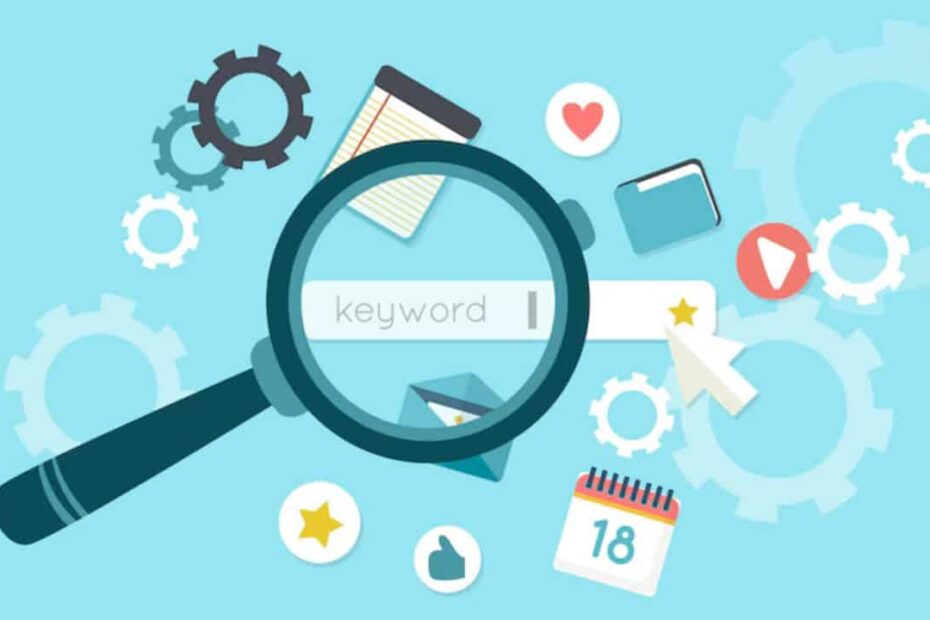What are the most typical SEO errors?
Table of Contents
How can you stay away from them?
Going all-in on SEO might be tempting for online brands and enterprises trying to improve growth through search marketing, but it can have negative effects if one isn’t careful.
SEO is a potent tool that is simple to use but challenging to master. A properly implemented SEO strategy can dramatically enhance search traffic; nevertheless, a poorly executed approach with frequent errors can cause a site’s ranks to drop, and you’ll start behind your rivals.
We will now discuss some typical SEO errors that might harm your website.
What is content optimization?
Content optimization aims to make a post’s or webpage’s content appealing to readers and search engines like Google and Bing. Simply put, every piece of information you create should be easy to find, well-structured, and have a high readability rating.
In addition to making it more straightforward for your target audience to access your material, paying attention to these characteristics will help you from an SEO standpoint to achieve higher search engine ranks.
Content optimization mistakes
1. Duplicate content
Website owners publish duplicate content accidentally and are sometimes unaware of it until they see a decline in ranks or website traffic.
Even though most website owners are aware of the dangers of “double posting,” there are other, less visible ways that identical information might appear, including secure HTTPS pages, URL parameters, and CMS designs.
To maintain your rankings and traffic, you must use the Noindex, Nofollow, or rel=canonical tags to instruct search engines not to index certain pages.
2. Not using Google Analytics data.
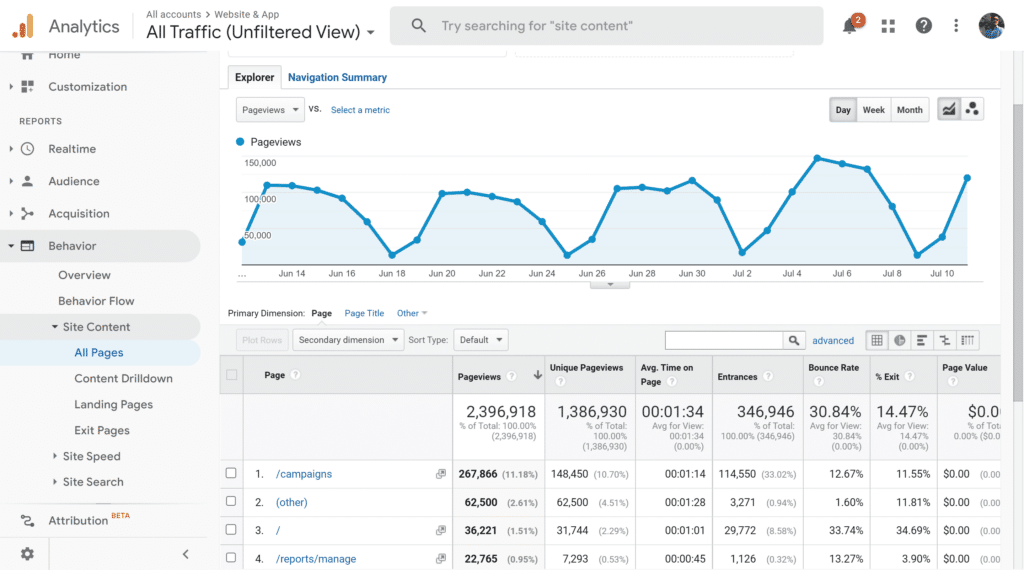
Google Analytics is well-known for its ability to monitor site traffic and user interactions. With the help of analytics, marketers may monitor traffic sources, conversion rates, user behavior on their site, and the most popular pages.
Without analytics, managing a successful SEO campaign and monitoring your progress over time will be much more challenging.
Analytics enables SEO professionals to identify which pages are doing poorly and which are beginning to perform well.
3. A headline that doesn’t match the content
The most crucial aspect of content optimization is probably your article’s or web page’s headline. Because it not only appears first on the search results page for your target audience, but it also provides information about the post’s or page’s content.
The headline of your post must be optimized as a result. When composing the headline for your article or page, keep the following rules in mind:
- Make an effort to explain the topic of your material and its value. This will enable you to quickly attract the attention of individuals seeking assistance with a specific subject.
- The headline should only be 50-60 characters long.
- For your material to stand out from rivals on search result pages, your headlines must be distinctive.
- To increase visibility, try to incorporate your main goal keyword within the headline.
- Make your headline as intriguing and captivating as possible, as it is the first thing users will see to increase search engine traffic.
- The rankings in search engines can be significantly impacted by adhering to these specific criteria when developing the headline for your article.
4. Having the Google Analytics tracking code set up wrong
You should ensure that Google Analytics is correctly deployed to ensure that it is gathering data accurately. Unfortunately, one of the most frequent SEO errors is adding the tracking code in the incorrect location, installing numerous tracking codes, adding ineffective custom code, or setting up custom filters that may significantly modify your statistics.
The best strategy is to install the tracking code by Google’s instructions, position it immediately behind the opening head > tag, and configure it using the Analytics default code. Maintaining an unfiltered default attribute in Analytics is another wise move that will ensure you always have unadulterated data at your disposal.
5. Default meta descriptions
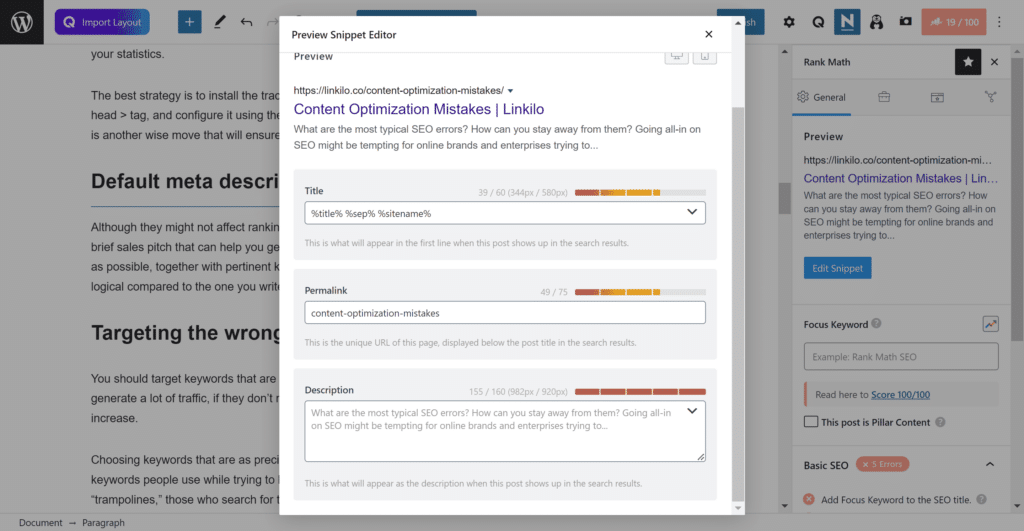
Although they might not affect rankings, meta descriptions are nonetheless significant. Meta descriptions offer a brief sales pitch that can help you get more clicks. A good meta description should be as descriptive and persuading as possible, together with pertinent keywords. However, this default description will probably not be as relevant or logical as the one you write yourself.
6. Targeting the wrong keywords
You should target keywords that are pertinent to the page you are optimizing. Although generic head keywords may generate a lot of traffic, if they don’t match the page’s content, users won’t convert, and your bounce rate will increase.
Choosing keywords that are as precise as you can while optimizing your website is crucial. You should target keywords people use while trying to buy trampolines. Although there is a lot of traffic for the general term “trampolines,” those who search for this term might be looking for a trampoline park in the area to purchase or to know what a trampoline is.
In this situation, less popular terms with a clear indication of a desire to make a purchase, such as “best trampolines for teenagers” or “trampolines for sale,” are more likely to result in conversions and lower bounce rates. Therefore, well-done keyword research should be the first step in any SEO campaign.
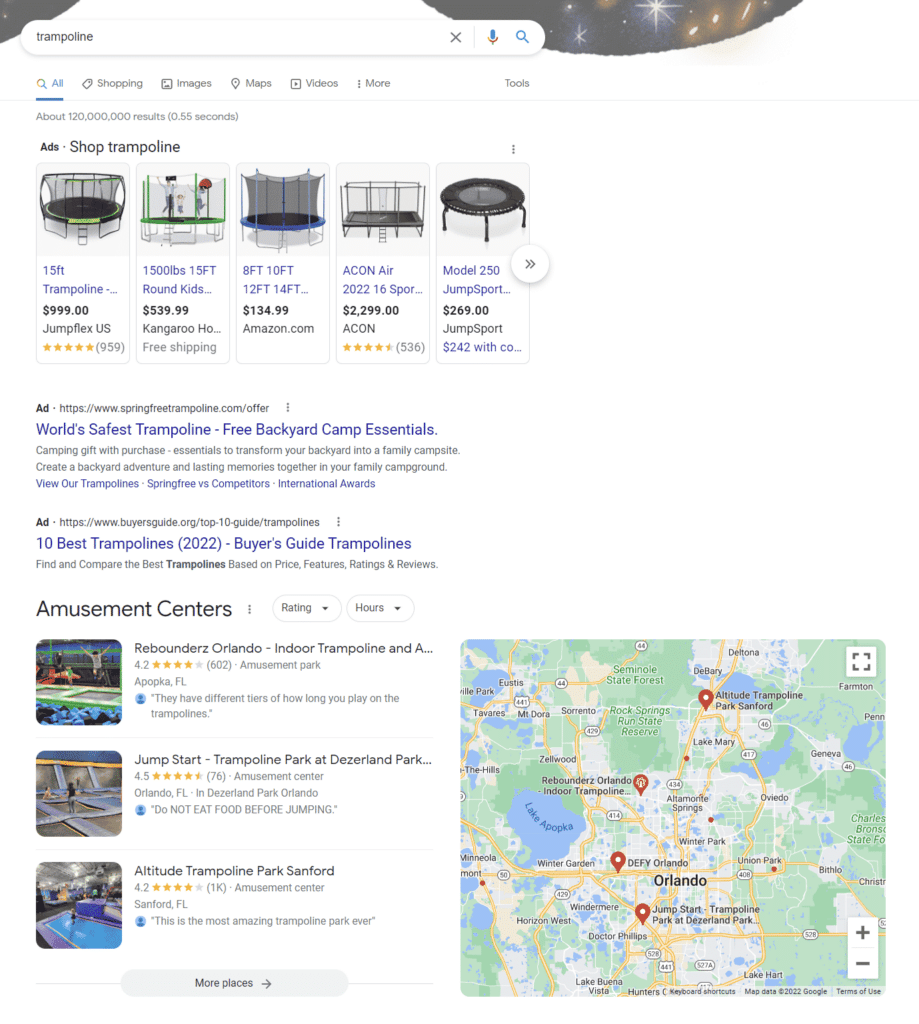
7. Too many inbound anchor text links
Excessive usage of exact match anchor text used to be a successful tactic. SEOs need to use their anchor text much more carefully now that Penguin 4.0 is a component of Google’s core algorithm. A page with an excessive number of inbound links containing the same term appears unnatural and may set off the Penguin algorithm.
Utilizing exact match anchor text remains crucial. However, you should switch up your anchor text and watch for many internal links leading to a single page.
8. Your HTML is not Google-friendly
Most individuals mistakenly believe that SEO affects your content and website layout. However, you might not be aware that arranging your HTML in a Google-friendly manner is a significant component of SEO unless you work in programming or web development.
The standard markup language for creating web pages is called HTML, which instructs your browser on how to display the text and graphics on a website. Ensure your HTML is Google-friendly by including all the necessary elements, such as title tags, meta descriptions, robot tags, header tags, alternative text for pictures, responsive site meta tags, and more.
9. Ignoring 404s or broken links
Although many people are aware that 404 errors are harmful, few webmasters take the time to update any broken links on their website and redirect any 404.
Even for low-ranking, low-value pages, this could seem like it is not worth the bother, but if you allow 404s to lie around, you could be losing rankings constantly. Excessive 404s could waste time for search engine robots like Googlebot and reduce your crawl budget.
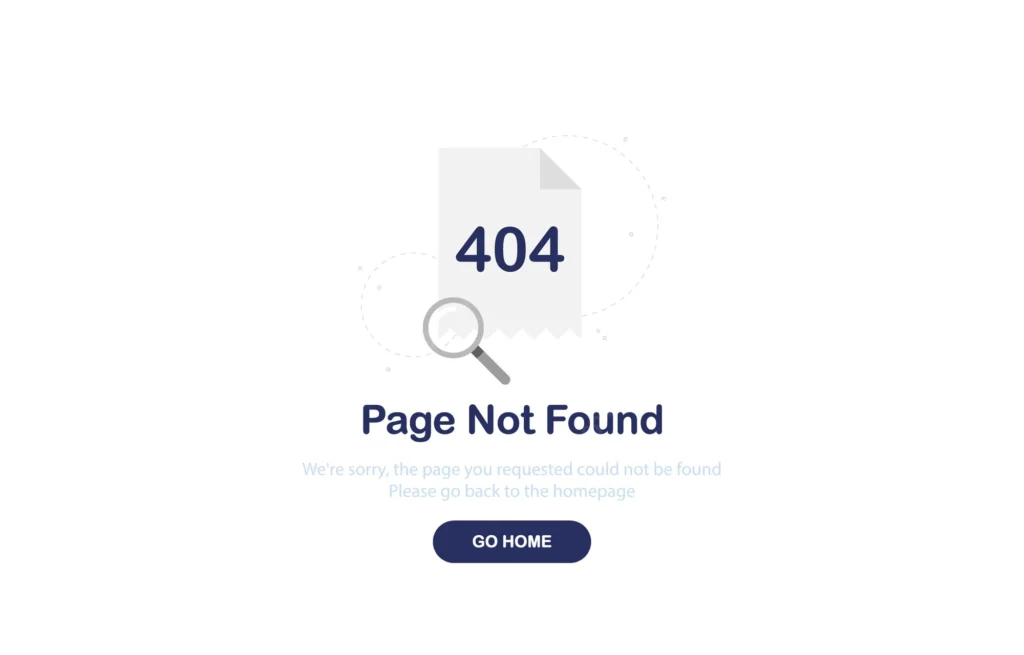
10. Bad sitemaps
Although many website owners and admins know the importance of sitemaps for SEO, they frequently set them and forget them. It’s not always necessary to keep an eye on a sitemap when the CMS or website platform is automatically building and updating one.
A sitemap, however, may occasionally not be updated regularly enough or be put up wrong, which might lead to problems. Including URLs for pages that have been deleted or are no longer active is a typical sitemap SEO error. Site maps shouldn’t contain 404 errors or redirects. There should only be 200 pages in them.
Other common errors with sitemaps include adding several URLs to the same page (non-canonical URLs), formatting them incorrectly, or making them too massive for Googlebot to crawl.
11. Non-secure HTTP sites

Even though this is a less frequent SEO blunder, many websites still use HTTP security. Site security is now considered when determining to rank for desktop and mobile websites, which implies that SEO performance may be impacted.
This is especially crucial for websites that accept online payments or where customers can submit private information. Make sure that this and other areas of your website do not continue to use HTTP protocols.
12. Poor page load metrics
Site speed and page load metrics have become increasingly important in SEO. According to Google, incredibly slow performance may negatively impact rankings in mobile search results.
Then, earlier this year, they announced that the user experience and SEO would be the primary focus of their new Core Web Vitals measures, which would eventually be incorporated into their main ranking algorithm.
Accordingly, individual pages’ LCP (Large Contentful Paint), FID (First Input Delay), and CLS (Cumulative Layout Shift) would affect SEO results. Unfortunately, it’s nevertheless usual for organizations to underoptimize these KPIs despite this and the clear benefit to users.
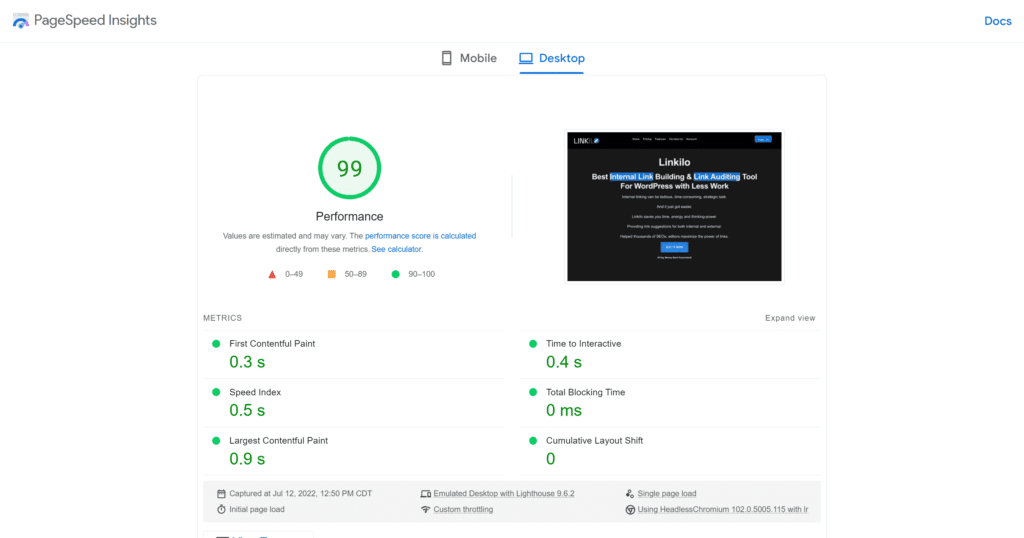
13. Not refreshing or updating old content.
With the Google freshness algorithm update from 2011, specific themes with older or dated content could perform worse in SEO. To maintain organic traffic, one of the worst SEO blunders many websites and online businesses make is continually producing new content.
However, as outdated articles, manuals, pages, and blog posts accumulate, they may disappear farther into the site’s hierarchy, or their content may become no longer valid.
The ideal strategy is to identify outdated articles or pages on your website declining in organic traffic and keyword rankings year over year (YOY) and determine whether they may use an edit or rewrite. Republishing with fresh content might also improve the SEO of your existing content.
14. Bad robots.txt settings
Most web admins and marketers know how effectively the robots.txt file is for managing search engine crawler bots. But one of the most frequent SEO errors is setting it up incorrectly and running the risk of indexing issues.
However, you shouldn’t use robots.txt to prevent Google from indexing your website. In reality, Googlebot has recently used indexing directives in robots.txt files as suggestions. The rationale is that Google can still access such pages via other links even though they won’t display the intended indexing status.
Using “noindex” or “nofollow” HTML tags within the source code of each page is a preferable method.
15. Lack of multi-media content
The Key is the content. One prevalent misconception about SEO is that content only refers to text. The search quality evaluator standards provided by Google provide additional guidance on optimal practices.
In addition to being of the highest caliber, content should emphasize meeting the needs of those who frequent the sites. It also explains how “page-quality” is not simply related to content but also how well-executed a page’s aim is when high-quality content is linked to it. This goal may involve:
- Sharing knowledge regarding a subject by distributing images, videos, or other media
- Expressing one’s views or ideas
- Entertaining
- Promoting goods or services
- Enabling users to write queries or responses
- Enabling people to download applications or share files
This suggests that other types of content are just as valuable. Many organizations have discovered that users can gain from a variety of site features, including tables, menus, forms, videos, photographs, graphics, etc., in the modern world of web marketing.
16. Missing out on image optimization
Including photos is one thing, but making sure they are contextually added as part of content optimization is another (and not just the stock photographs) properly named (and not just logo-1.jpg) correctly described with the appropriate ALT attribute (and not just logo-1)
17. Page load times
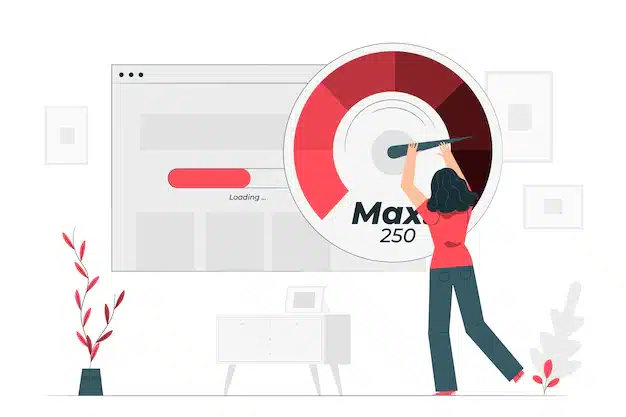
Page load time is a crucial SEO aspect because search engines utilize it as a ranking factor. Unfortunately, user experience is impacted by page load speed because even a 2-second delay can cause abandonment rates of up to 87%.
Fortunately, various tools are available to examine page load time and maybe identify the root cause of the delay. You can also optimize website load time in advance by using fewer redirects and too many plugins, CSS, and HTML.
Conclusion
You can avoid the content SEO blunders outlined above by focusing more on your audience and brand than on the search engines. With the help of this post, we hope you have finally been able to recognize the errors you have been making and have learned how to correct them so that your content is optimized properly.
Although content optimization may seem difficult, it is pretty simple. To rank highly in search results, you must develop the habit of working on your title, correctly formatting your content, and adhering to the other content optimization guidelines.

